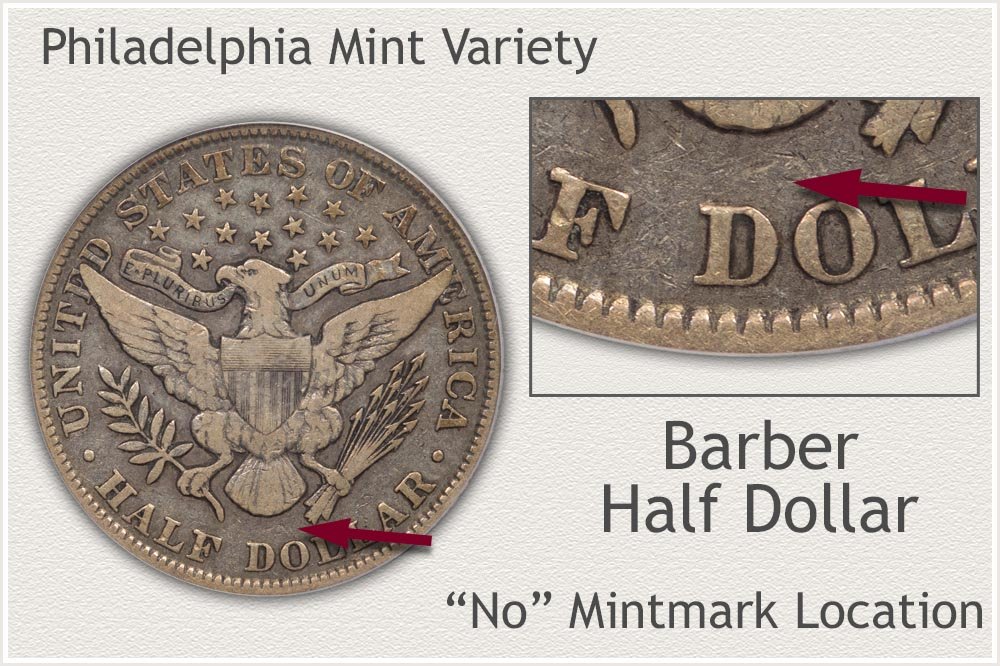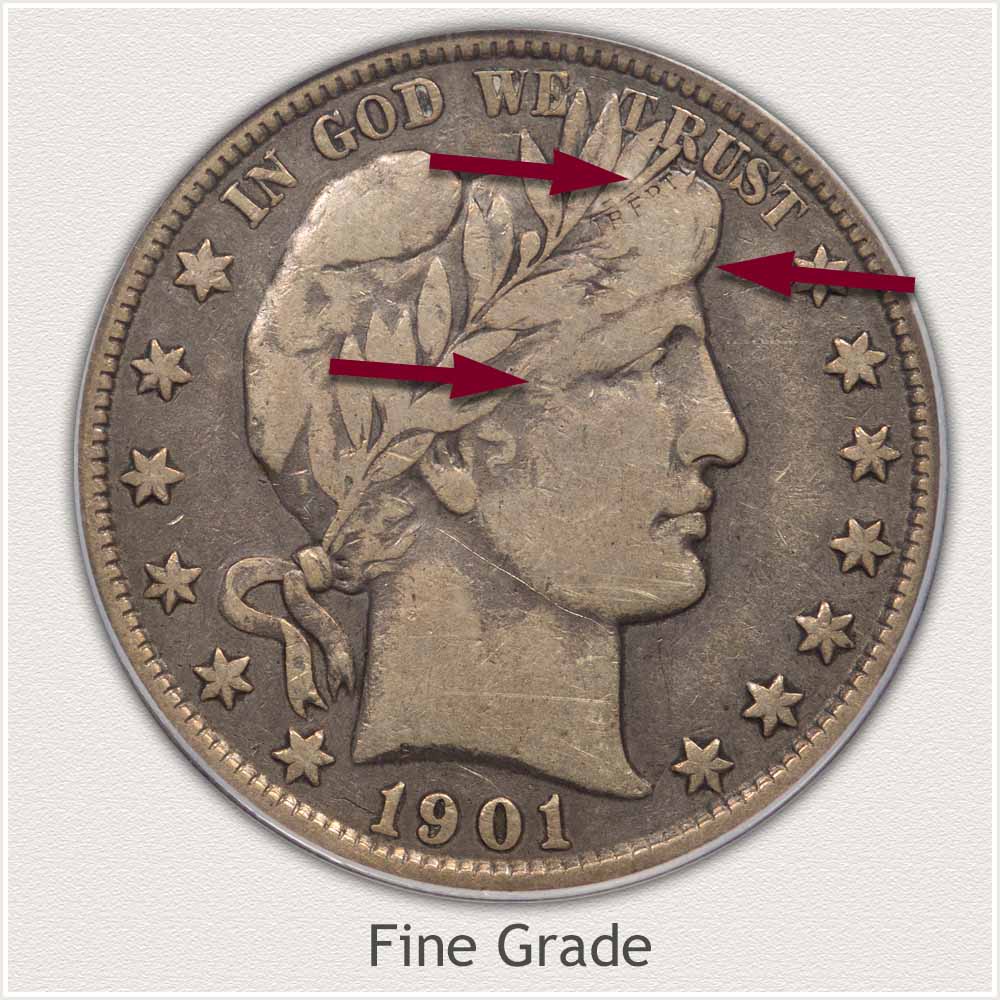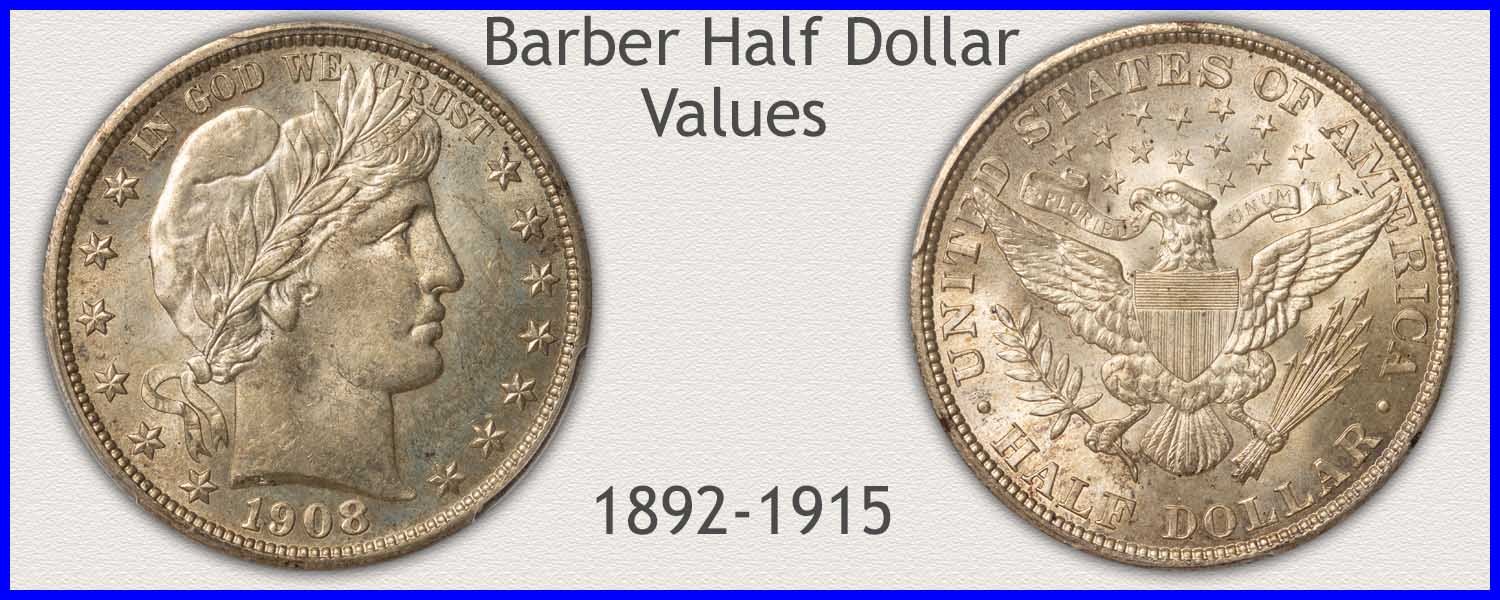Coin Values Moving with Precious Metals: Up-Dated 12/8/2025: Gold $4212 | Silver $58.12
1904 Half Dollar Value
A correct 1904 half dollar value is found on the chart by following a few steps. Of importance is three mints produced halves in 1904, creating a variety of mints to identify.
Also, each coin is evaluated and given a value based on its condition. Interest in these coins is found in two large and separate markets. First are collectors, from beginner to advanced, looking for collectible quality examples. Second are investors in precious metals, wanting to buy silver at its bullion value.
The range listed on the chart reflects the range of scarcity of coins available. Discover the worth of these Barber halves by using a step-by-step method.

Steps Leading to Value:
- Step 1: Date and Mintmark Variety - A detailed examination is needed to separate the scarce mint variety. Mintmarks identify the specific mint producing the half dollar.
- Step 2: Grading Condition - High-quality Barber halves are popular. Condition is defined by the grading process, helping find its place on the chart.
- Step 3: Special Qualities - As you proceed, record progress to save important information about quality, dates and mints.
| 1904 Half Dollar Value | ||||
|---|---|---|---|---|
| Condition of Coin | ||||
| Date | Good | Fine | Extremely Fine | Mint State |
| Barber Half Dollar Values Updated | 12/8/2025 | |||
| 1904 | $34.62 | $71 | $171 | $447 |
| 1904 O | $38.35 | $123 | $433 | Rare |
| 1904 S | $44 | $350 | $2,349 | Rare |
The above Coin Value Chart is a listing of Wholesale values. Computed by applying a mark-up factor specific to Barber half dollars to an average of retail prices and auction results.
Step 1: | Date and Mintmarks Important to Collectors and Premiums
San Francisco Mint Issue Leads 1904 Half Dollar Value
There is an increase in value for a scarce mint variety in 1901 as a result of its popularity and low production. Throughout the Barber half dollar series, San Francisco mint often contributed the fewest half dollars to the annual total.
Each branch mint strikes coins with its own mintmark that identifies the variety. Examine and record the exact date and mint combination.
1904-S Barber Half Dollar
"S" Mintmark on Reverse: San Francisco Mint Struck the Coin

San Francisco mint recorded just 533,038 half dollars were struck and released into circulation in 1904. This production became the lowest yearly total from the facility of the entire series. Due to its low record setting mintage, this coin is high on collector's want lists. Since they are hard to find in quality condition, they are worth much more than their base silver value.
To complete their collections of Barber half dollars, collectors look for particularly well-detailed examples. An elusive and rare coin to obtain.
San Francisco issued half dollars with a "S" mintmark to indicate their production. If there is a "S" on the reverse, below the eagle's tail feathers and above "HALF DOLLAR," it confirms the San Francisco variety.
1904-O Barber Half Dollar
"O" Mintmark on Reverse: New Orleans Mint Struck the Coin

Half dollars were being produced in greater quantities at the New Orleans mint by the turn of the twentieth century. Half dollars circulated widely in 1904, requiring the mint to produce a series average of 1,117,600 to support commerce. Most were never saved, instead remaining in circulation until they were heavily worn and withdrawn. Today, a well-detailed example is a special collector quality coin. Interest and premiums are high in the hobby, due to their connection with the popular New Orleans mint as well as a scarcity of collectible quality.
Examine the coin's reverse for the "O" mintmark, confirming the New Orleans issue. A large "O" mark representing New Orleans, is found in the space below the eagle's tail feathers and the lettering of HALF DOLLAR. To complete a value assessment, correctly identify these special coins.
1904 Barber Half Dollar
No Mintmark on Reverse: Philadelphia Mint Struck the Coin

By the year 1904, the Philadelphia mint had increased production to where it was striking more than 2 million half dollars per year. Today's collectors have an ample supply of these halves. Also, metal investors seek coins in the lower range of condition because of their heavy silver content. Because typical, worn examples are valued close to how much silver they contain, Step 2 Grading Condition is needed to find an accurate value.
During the Barber series, Philadelphia did not use mintmarks on coinage. If the space between the eagle and "HALF DOLLAR" on the reverse is empty, Philadelphia struck the half dollar.
Step 2: | Grading Condition Using Images and Descriptions
Accurate Judgment of Condition Finds Premium Quality
Depending on the amount of wear, if any, to a coin's surface, match to the images of the different Grades. These "Grades" are definitions of stages of preservation and used by collectors when describing each coin.
Dates, mints, and condition help form a complete identity of these old half dollars. Used in value charts, a grade narrows the range of premiums placed on collectible coins.
Mint State Grade

Mint State: Rarity of the Mint State condition, combined with its eye appeal, distinguishes this high-quality coin. The definition of a coin in Mint State condition is one with no wear on its surface. Highest and most delicate parts of a coin's design start to quickly show wear as soon as it is placed in circulation. A thorough inspection confirms the condition of critical areas.
No wear has smoothed or reduced any design element, as noted when examining the edges of the leaves within the wreath closely. When inspecting leaves in the lower row, confirm they have the same color and shine as the leaves in the upper row. Texture of the metal becomes smooth, the "white" shine of luster disappears, and silver takes on a soft-gray hue if any wear is present.
An examination of Liberty's check, which is an open area, must also remain unaffected by wear and covered in luster. High and low points of the contours are both lustrous and match in color and texture.
Barber halves of exceptional quality are in high demand among collectors.
Extremely Fine Grade

Extremely Fine: A half dollar in Extremely Fine condition displays only very light observable wear. These coins have small areas that are flattened by wear. In addition, the surface has been largely smoothed, and the silver has changed to a soft gray hue.
To identify the grade, it is necessary to judge important design elements are still present. The lettering "Liberty" appears above Liberty's brow within her headband. Inspect closely and determine every letter is bold and complete. The full ribbon edges that are visible above and below the lettering is another requirement to meet the grade. This full ribbon gives a coin its sharp appearance and aids in confirming its extremely fine grade.
Next, the leaves on the laurel wreath are all clear and separate, another sign of an above average quality half dollar. There are distinct high and low contours within the leaves, and there is no blending of leaf edges where they overlap. All combined, clearly visible features add to a quality appearance and collectible grade.
Fine Grade

Fine Grade: Once blending of major design features is visible, these half dollars are now in the Fine category of condition. Fine grade is defined as a coin with moderate wear and some merging of key areas of design.
Looking just over Liberty's eye, the area is now a completely flattened, smooth spot. Her hair no longer shows a separation from her forehead. The headband with lettering has lost its lower edge. A smooth area extends to her ear. A defining element placing the coin in Fine Grade is lettering of "LIBERTY" within the headband is readable. Mostly bold, slight fading along the bottom of central letters is often seen.
Tilting the coin under a light, note how the forehead, cheek under the eye, and nose are becoming connected in the same flattened height. Once rounded, these areas are now visibly smoothed and leveled.
Remaining boldness of the rim, date, and stars helps maintain an amount of detail presenting a pleasing, moderately worn half dollar.
Good Grade

Good Grade: Heavy wear, leaving the portrait as an outline without blending into the background, is what defines the "Good" grade. It is crucial that major design elements on coins in this condition retain a level of complete separation.
Often, especially near the top, Liberty's wreath within her hair reveals small traces of leaves. Her ear and eye are still discernible, but the line defining her jaw is either very faint or not present at all.
A full rim is also required, with no areas merging with the motto or stars. Each remaining feature of a collectible coin is well raised from the field, giving the impression of crispness overall.
How to Video: Grading Barber Half Dollars
Within each stage of condition, a few important areas are key to confirming a grade. Additional descriptions highlighted with images help recognize true state of preservation.
Video, Images and Descriptions | Grading Barber Half Dollars
Step 3: | Special Qualities | Organized and Recorded
Recognize Value of Barber Half Dollars
Barber half dollars are a series typically valued based on collector quality or silver bullion value. Identifying and recording specifics of each coin is an important part of determining its true worth.
 Preview Image of Coin Values Worksheet
Preview Image of Coin Values Worksheet
Mark the current date on the sheet, half dollars valued based on silver price change often over time.
Of particular importance is the column - Date/Mint. Defining coins starts with their exact date and mint variety. A full listing of coins always includes these facts.
Denomination/Series - column records these half dollar as: 50C Barber Series. Helping establish a full identity and description.
Next is the Grade column, a judgment of condition aided by the grading images and descriptions. Enter for Grade a conservative assessment of condition. This is always a good starting point in the recording of information. As experience grows, a keener insight is gained.
Using the key elements now recorded, entries in the value column become a narrow value range. A total of the collection is determined. Accurate information is organized so future decisions as to dispersal/selling, or keeping are on record. How much your holdings are worth is quickly determined.
Half Dollars of collector quality and premiums are easily recognized by their listing on the worksheet. Special quality coins become highlighted. Print additional worksheets to continue with the rest of your collection. Organized and ready to receive additional notes and experiences.
References
U.S. Mint. 1905 U.S. Mint Annual Report
https://nnp.wustl.edu/library/book/514121
U.S. Mint. Catalogue of Coins of the United States.
https://nnp.wustl.edu/library/book/554591
Coin Values | CoinStudy Articles
Date by Date
In Depth Barber Half Dollar Values
1892 to 1915
Barber Half Dollar Value | Scarce Date and Mint Varieties
1904 Barber half dollar is part of a long running design series. The many date and mint varieties are covered in detail and listed on the value chart. Confirm date and mint combination, judge condition to narrow how much these old half dollars are worth.
Coin Value Guide | How to Value a Coin Collection
All coin collections have special qualities. Many were assembled long ago and have aged quietly. Many collections have increased in value because of their undisturbed nature. Follow the steps outlined to recognize special qualities and value a coin collection. Important factors: dates, mintmarks, and condition are evaluated in-depth.
Print the Coin Values Worksheet
A quick listing of your coins, including an accurate recording of the key elements to value, provides an organized reference. How much your holdings are worth is quickly determined. Print the value sheet to start with your Barber half dollars.
Safe Coin Storage | Recommendations
Once removed from circulation and then provided with protective housing, old coins maintain their value. Specific to coins and coin collecting are storage options to hold single or multiple coins. Premium coins are protected and safe from damage. Review the storage solutions.
Sell Silver Coins | Identify Vintage Silver Issues
First recognize the different silver alloy coins minted by the U.S. Vintage series of dimes, quarters, half and silver dollars, those containing silver, are now worth well above face values. Using the calculator updates current worth. Referencing a listing of dealers finds potential buyers.
★Coin Values Discovery finds 1904 Barber Half Dollar Value and...
U.S. coin value charts, plus a step-by-step method, finds a narrow range of how much old coins are worth. Begin here with in-depth coverage of the important features to identify on each coin. Dates plus mint varieties are identified, judging condition with images and video; also, identifying special qualities finds the potential in a box of old coins.
